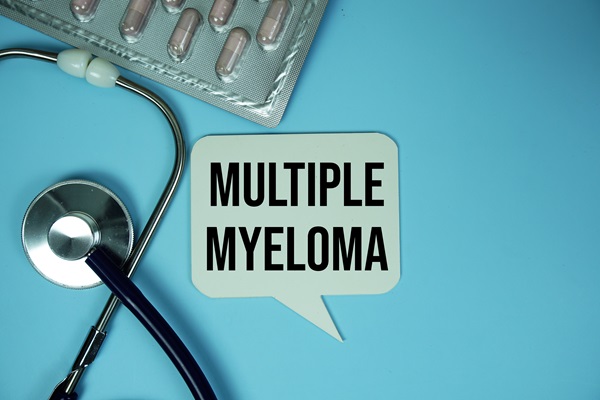A Guide on Choosing the Right Multiple Myeloma Treatment Option

Navigating the complexities of multiple myeloma treatment can be overwhelming for patients and their families. With various treatment options available, it is important to make an informed decision in order to manage their disease effectively. Whether you have been recently diagnosed or are exploring new treatment options, understanding the different options can help you make the best choice for your specific situation.
Factors in a multiple myeloma treatment plan
When a patient has multiple myeloma, the oncologist and the rest of their healthcare team will create a treatment plan personalized to their unique needs. When deciding which treatments to offer, the oncologist will consider the following factors:
- The patient's age and overall health
- The severity of any existing symptoms
- Complications from the disease (i.e., impaired kidney function)
- The patient's eligibility for a stem cell transplant
- The type of multiple myeloma
- The stage of multiple myeloma (stages 1-3)
- Previous treatments and the patient's response to them
While there is no cure for multiple myeloma, the treatment can help reduce symptoms, slow its progression, or put the disease into remission. For multiple myeloma, remission means that most or all signs and symptoms disappear.
Multiple myeloma treatment options
In many cases, patients may not need multiple myeloma treatment right away. If they are not experiencing symptoms, the oncologist can continue to monitor the progression of the myeloma through blood and urine tests, looking for signs of the myeloma worsening. This stage of multiple myeloma is known as "smoldering myeloma."
In contrast, when this disease causes symptoms, treatment often begins with medicine. Multiple myeloma treatment can help control complications, relieve pain, and slow the growth of the myeloma cells. Common treatments include:
Chemotherapy
One of the most common treatments for multiple myeloma is chemotherapy. It works by killing rapidly dividing cancerous plasma cells. While effective, chemotherapy can also affect healthy cells and is known for side effects, such as:
- Nausea and vomiting
- Fatigue
- Hair loss
- Mouth sores
- Skin and nail changes
- Changes in taste and smell
- Fertility issues
In some cases, chemotherapy can be used with other treatments to improve its effectiveness.
Stem cell transplant
When combined with high-dose chemotherapy, a stem cell transplant — also known as a bone marrow transplant — replaces diseased bone marrow with healthy bone marrow. Before this procedure, the oncologist will collect blood-forming stem cells from the patient's blood. After receiving high doses of chemotherapy to destroy the disease bone marrow, the stem cells are put back into the patient's body. These cells will travel to the bones and rebuild the bone marrow.
The patient can use bone marrow from their own cells; this procedure is known as an autologous bone marrow transplant. However, there are cases when they may be unable to undergo this process. A healthy donor can donate their stem cells in an allogeneic bone marrow transplant. It is important to keep in mind that not everyone is a candidate for a stem cell transplant, which depends on the patient's overall health and the stage of their multiple myeloma.
Targeted therapy
Targeted therapies are designed to specifically attack specific chemicals in the cancer cells without harming normal cells. By blocking these chemicals, targeted multiple myeloma treatments cause the cancerous cells to die. This type of multiple myeloma treatment includes drugs like proteasome inhibitors and immunomodulatory agents. Targeted therapy can be effective in patients with specific genetic profiles, which offers a more personalized approach to multiple myeloma treatment.
Immunotherapy
Immunotherapy is a multiple myeloma treatment that helps the patient's immune system kill cancer cells. This disease spreads by allowing cancer cells to hide from the immune system. Immunotherapy helps the immune system find and eliminate cancer cells before they spread to other parts of the body.
CAR-T cell therapy
Chimeric antigen receptor T-cell therapy, also known as CAR-T cell therapy, involves training the patient's immune system cells to target and fight against multiple myeloma. This treatment starts with extracting certain white blood cells, including T cells, from their bloodstream. These cells are then taken to a laboratory where they are modified to produce specific receptors. These receptors enable the cells to identify a particular marker on the surface of the myeloma cells.
Finally, the cells are put back into the patient's body. As a result, the modified cells can now find and destroy the multiple myeloma cells.
Call our office to get started
The Lindenberg Cancer & Hematology Center aims to ensure each patient gets a multiple myeloma treatment plan that specifically fits their needs. We will work with you to develop a treatment plan that aligns with your goals. Call our Marlton office to learn more about our treatment options or to schedule an appointment.
Request an appointment here: https://lindenbergcancer.com or call Lindenberg Cancer & Hematology Center at (856) 475-0876 for an appointment in our Marlton office.
Check out what others are saying about our services on Yelp: Multiple Myeloma Treatment in Marlton, NJ.
Recent Posts
Gynecological cancer treatment is a complex and often emotionally challenging journey. Patients and their families frequently have questions and concerns about available options, potential side effects, and long-term outcomes. The following guide provides answers to some of the most common questions about gynecological cancer and what you can expect from the treatment process.According to Johns…
Navigating the effects of gastrointestinal cancer treatment involves more than managing the disease itself. Patients often encounter a wide range of physical and emotional symptoms that affect daily comfort, appetite, strength, and rest. A proactive approach to symptom management can ease this burden, enhance treatment outcomes, and support a higher quality of life throughout the…
A visit to a cancer doctor often feels overwhelming, but understanding what a cancer doctor does and how the first appointment unfolds reduces anxiety and supports confident decisions. A clear idea of what to expect allows patients and families to prepare questions, gather records, and take an active role in care from the very first…
Blood health is an important part of maintaining your overall well-being. A hematologist is a medical specialist trained to diagnose and treat blood disorders. These medical professionals can provide critical support for those managing conditions that affect red blood cells, white blood cells, platelets, bone marrow, or the lymphatic system. Having access to this specialized…


